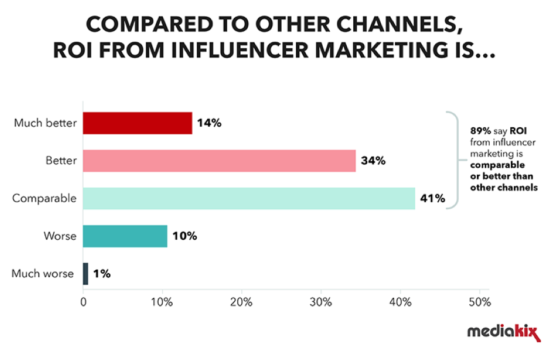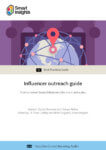How influencer marketing can fail if you chose the wrong influencer, channel of promotion and don't understand the audience you're targeting
Question: would you rather spend thousands (or even hundreds of thousands) for an influencer with 1m+ followers on social media or web traffic but has much lower brand loyalty and even less public trust, or spread your budget across many smaller micro/nano influencers whose reach online is less but following much more loyal?
First, let's look at some influencer marketing stats...
- 80% of marketers find influencer marketing to be an effective strategy.
- 89% of marketers say that influencer marketing offers ROI that is comparable to, or better than, other marketing channels.
- 61% of marketers agree that finding the best influencers for a campaign is a big challenge.
- On average, businesses generate $6.50 in revenue for each $1 invested in influencer marketing.
- Over 60% of Instagram users are between the ages of 18 and 24. Perfect for targeting millennials.
- Nearly three-quarters of Instagram influencers fall into the 18- to 34-year-old age range.

Amongst many other recent research studies, the common consensus is that influencer marketing is the "next big thing" in marketing (or has been for the past few years). Every year marketing publications state that influencer marketing will be huge, whether that be via a new channel, an improved channel or via new routes to working with influencers, it's always on the list of trends many big names in marketing think you should to adopt.
Download our Individual Member Resource – Influencer outreach guide for marketing professionals
Learn how to convert brand influencers into brand advocates using social media and which use tools to find and interact with influencers on the best social media platforms for outreach.
Access the Influencer outreach guide for marketing professionals
But why do marketers keep banging on about investing in influencers?
Firstly, influencers are not "social media gods" or some higher entity that will magically bring about an increase of 110% in profits for endorsing your product/service overnight. Neither are they only A-list celebrities on TV or in Hollywood films anymore, they're human.
The idea of what makes an "influencer" has changed within the last 2 decades as the influence of online media grows, the use of social media increases and the ease of creating a blogging site becomes more accessible. From TV, print, and radio ads containing "A-list celebs" endorsing products to micro-influencers with a smaller but more loyal following, brands now have, more than ever, more choice and versatility in their influencer campaigns.
They're vloggers, bloggers and social media icons - they're anyone that has influence. But they're not always a name and a face - influencers can also be review sites and bloggers who have sufficient click through and buying traffic.
These types of influencers are becoming more and more important as millennials and the younger generations move away from traditional media engagement, like TV adverts, and spend more time online whether that be on social media or browsing review sites for best recommendations.
So, what makes a person an "influencer"?
"Influencers can either be traditional TV personalities with large online followings; or reality TV stars who have achieved influencer status through TV; or self-made online stars who have become influencers in their own right through YouTube, Instagram or Facebook." - IBC
But being a "star" does not always make you an influencer...
By definition, an influencer is a person, or site, that influences a users thoughts about a brand or product and encourages them to carry out the desired action (click-through, purchase, etc.) They need to influence an action in order to be an influencer - the number of followers or site traffic they receive will help them become a credible icon in the industry but does not mean they influence any of their followers' decisions.
Many people tend to think anyone can become part of an influencer programme as long as their social following or site count is deemed worthy - but this does not mean they actually have influence. When deciding who to use in your next campaign, don't just look at the vanity stats (amount of traffic, social count, etc.). Make sure you dig deeper and understand how long their audience stays on their site, how many sessions they have, what is their percentage buying traffic, have they got positive engagement on social posts, are they being shared around in relevant networks etc.
What are the types of influencer marketing?
Influencer marketing is a subsidiary branch of affiliate marketing, a performance-based practice that rewards "affiliates" (influencers/sites, etc.). However, the difference between affiliate and influencer marketing is the level of input the brand puts in. Whereas affiliates will work on their own marketing efforts to drive traffic and conversions to a brand's site with the guidance of brand guidelines, brands will work closely with influencers on each post (in certain cases scripting their social posts - although this is not an authentic form of marketing).
If you're considering spending budget on influencer marketing, why not consider how you can also harness the whole power of influencer marketing into one cohesive strategy? Why? Because the paid/sponsored type of influencer marketing is not always effective:
"70% of millennial consumers value peer endorsement over celebrity endorsement."
Word of mouth and endorsements from close friends and family within a consumer's first connections network is still highly valuable. What forms of influencer marketing can you get involved with?
- Sponsored social media content
- Sponsored blog posts
- Guest blogging
- Brand Ambassador programmes
- Host giveaways
But remember, an influencer and a brand ambassador can be different people. A brand ambassador is linked to your brand, and when you think of them you think of the brand. This doesn't mean they're influencing people's decision to buy the brand's products, but more developing a link between status and brand. Having a brand ambassador with as large a following as possible is better for reach and brand awareness, but influencers need to a have loyal following in order to prompt action, or else you're wasting your time and money.








